How to Navigate the Complexities of Mission-Critical Vendor Management
In Summary:
-
Today's average public safety agency has more than 30 vendor support agreements to manage.
-
Vendor support agreements have become more difficult to understand given their size and complexity.
-
Public safety organizations are looking for strategies to help navigate the complexities associated with today's increasingly complicated vendor environment.
It used to be much easier for public safety agencies to manage their vendors compared to a decade ago. At that time they were simple and easy to understand and they generally only involved the radio, computer-aided dispatch (CAD) and 911 call-handling system providers.



